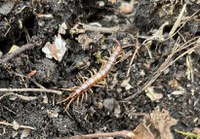Dakota Gardener: A predator in the garden
(Click an image below to view a high-resolution image that can be downloaded)
By Carrie Knutson, Horticulture agent
NDSU Extension – Grand Forks County
I was planting some early onions in my garden and was surprised by a garden critter. I watched in amazement as it scurried across the soil looking for cover. I was glad I had enough time to snap a few pictures as I had found my inspiration for my upcoming garden column!
What was the critter that had me so amazed? Why a centipede of course! Centipedes are a common insect relative found in the garden. They are not true insects as they only have two body regions and a variable number of legs.
Centipedes have one pair of legs for each body segment. The number of body segments depends on the species as does the environment in which they live. In addition, they have long, segmented antennae. House centipedes and Stone centipedes are common species in our area. House centipedes have long slender legs that are about one inch long, while stone centipedes are 1 to 2 inches long.
Centipedes favor moist conditions. In the garden, that can be under rocks, organic matter or in the top layer of soil. They are garden predators using their fangs and sharp feet to capture their prey. They do produce venom to subdue their prey. Centipedes will prey on small insects, spiders and even worms.
Centipedes will usually try to avoid contact with us and dart quickly for cover. They can bite, but smaller centipede fangs are usually not strong enough to break skin. However, larger centipede species like the Giant centipede can be aggressive, resulting in painful bites that may need medical treatment.
Millipedes are another common insect relative in the garden that are easily confused with centipedes. Millipedes have two legs per body segment and long tube-shaped bodies. They are slow moving and do not have fangs. They are detritivores, meaning they eat decaying plant material helping to cycle nutrients in the garden. Note, they will eat ripening fruit that is at ground level.
Millipedes will often coil up in a circle for defense. They can also release chemicals to help repel predators. If our skin encounters these chemicals, they can irritate and discolor our skin.
Sometimes, centipedes and millipedes will migrate into our homes in search of cool moist environments. They will not cause any damage inside, so they are more of a nuisance pest. Their presence warns us of damp conditions in our homes and maybe the issue of other insects, especially for centipedes. Sealing cracks in the basements, removing hiding places (boxes etc.) and using a de-humidifier can help prevent them from making your home their home.
Both centipedes and millipedes are considered beneficial in the garden. So, I was very happy to see a centipede in my garden. Keep your eyes open as you are working in your garden this summer. See how many centipedes or millipedes you can find.
Happy gardening!
NDSU Agriculture Communication – May 29, 2024
Source: Carrie Knutson, 701-780-8229, carrie.knutson@ndsu.edu
Editor: Kelli Anderson, 701-231-7006, kelli.c.anderson@ndsu.edu




